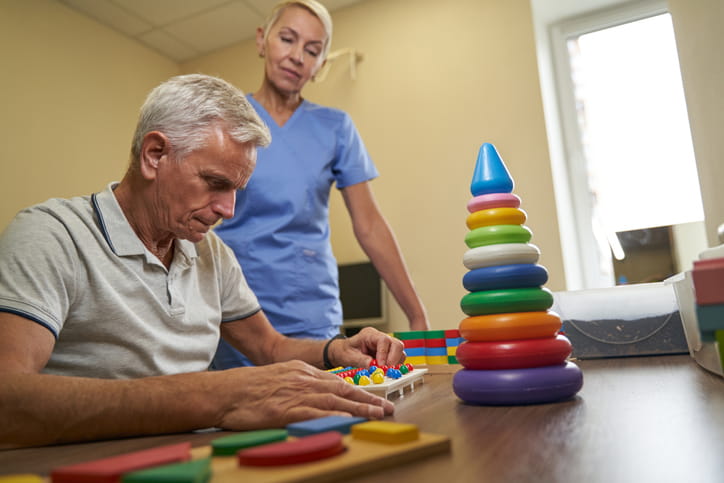What Is The Difference Between Occupational Therapy And Physical Therapy?

Considering that physical therapy and occupational therapy are both designed to assist patients with living more easily, more independently, and more comfortably, the distinctions between the two can be confusing. Over 50 million people pursue physical therapy every year to improve their mobility and physical functioning, whereas occupational therapy statistics are difficult to find because occupational therapy tends to be a bit vague, and is used as a broader term. Keep reading to learn more about what distinguishes these two therapies.
Are You Looking For Occupational Therapy In Utah? Check Out Monument Health Group Today.
What Is Occupational Therapy?
According to the Cleveland Clinic, occupational therapy is used as part of a treatment plan designed to help patients better perform daily activities. Occupational therapists focus on teaching patients to safely move throughout their day-to-day life and/or how to use tools to assist with activities of daily life. Occupational therapy is used to treat disabilities that result from injuries or chronic conditions that have made certain required daily movements difficult to perform.
What Do Occupational Therapists Do?
Occupational therapy is generally done in the following three stages:
- Assessment
- Interventions
- Evaluations and outcomes
Assessment: When you first begin occupational therapy, the first step will be to discuss what the problem is, what specific issues are challenging for you, and what your goals are for therapy. Your occupational therapist may suggest watching you make certain movements and/or watching you try to perform certain tasks to ascertain what type of help you require.
Interventions: This stage varies depending on the condition. For example, if you’ve recently lost a limb or become unable to walk, you may be taught how to use an assistive device, such as a wheelchair, or how to properly use a prosthetic device. In other cases, therapy will merely consist of specialized exercises to teach you how to better perform daily tasks, such as dressing on your own, grooming independently, cooking safely, using the computer, driving, etc.
Evaluations and outcomes: This is an ongoing phase designed to keep you and your occupational therapist talking about how you’re improving from their professional perspective, how you feel you’re improving, and whether your goals or these interventions need to be adapted or changed in any way for the best chance of success.
Occupational Therapy Can Be Used As Part Of A Treatment Plan For The Following Conditions
Chronic Conditions
- Multiple sclerosis (MS)
- Spina bifida
- Cancer
- Cerebral palsy
- Parkinson’s disease
Injuries
- Burns
- Bone fractures
- Carpal tunnel
- Amputation
- Traumatic brain injuries (TBI)
- Hand injuries
- Spinal cord injuries
- Strokes
Disabilities
- Autism
- Developmental delays
- Down syndrome
Surgeries
- Joint replacement
- Spine or head injury surgery
- Abdominal surgery
- Amputations
What Is Physical Therapy?
According to the Cleveland Clinic, physical therapy (also referred to as physiotherapy) is often part of treatment plans meant to help patients improve the way they physically move their bodies. Physical therapy is used to treat issues with pain, improve/maintain mobility as an injury heals, and assist with the treatment for certain chronic conditions. In physical therapy, you will be taught a series of exercises and stretches to strengthen your muscles, help you increase or maintain a full range of motion during healing, increase flexibility, and maintain or increase mobility.
How Does Physical Therapy Work?
In physical therapy, physical therapists work with patients to create a treatment plan tailored to their specific issue and then supervise and/or assist them in these movements to ensure they are done correctly, without further injury. With severe cases (or for the first appointments after a surgery), physical therapy may begin with a physical therapist moving the affected part of your body for you to maintain blood flow and mobility.
Once it has been determined that you can complete exercises independently, physical therapy consists of a mixture of the following treatments (depending on your specific issue):
- Stretches
- Strength training exercises (with and without weights and/or resistance bands)
- Massage therapy
- Cold therapy
- Hot therapy
- Hydrotherapy
- Time hooked up to a TENS (transcutaneous electrical nerve stimulation) unit
Physical Therapy Is Often Used As Part Of A Treatment Plan For The Following Conditions
Chronic Conditions
- Multiple sclerosis (MS)
- Parkinson’s disease
- Muscular atrophy
- Cystic fibrosis
- Cerebral palsy
- COPD (chronic obstructive pulmonary disease)
Injuries
- Injuries from sports
- Chronic pain in the hips, back, knees, or neck
- Carpal tunnel
- Tendonitis
- Rotator cuff tears
- Knee ligament injuries
- TMJ (temporomandibular joint disorders)
- Concussions
- Strokes
- Spinal cord injuries
- Traumatic brain injury
Occupational Therapy vs. Physical Therapy
The biggest difference between occupational therapy and physical therapy is the objective. The intent of occupational therapy is to help patients perform the necessary daily tasks for living independently, whereas physical therapy intends to help patients move more easily, safely, and without pain.
Therapy Services In Utah
Whether you’re looking for occupational therapy or physical therapy, you will find comprehensive treatment plans for both at a Monument Health Group skilled nursing facility in Utah. Monument Health Group provides customizable treatment plans to fit every patient’s recovery needs.
For comprehensive, top-quality care from expertly trained staff in a compassionate environment, call Monument Health Group today.
In 2023, roughly 52,600,000 people experienced injuries severe enough to seek professional medical consultations. Often, seeking rehabilitation services, such as occupational therapy or physical therapy, gives patients the best chances of a full recovery.
Are You Curious About Post-Traumatic Injury Care? Check Out Monument Health Group Today.
Sources:
Home and Community Overview. (n.d.).
Occupational Therapy. (2024).
Physical Therapy (Physiotherapy). (2024).
Salamon, M. (2024). Physical Therapy: Myths Vs. Reality.
